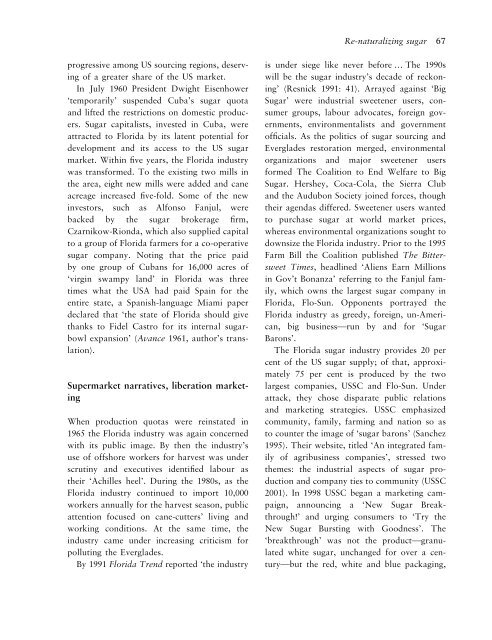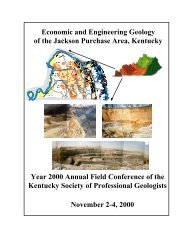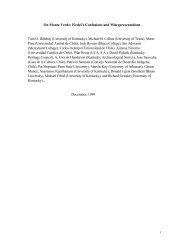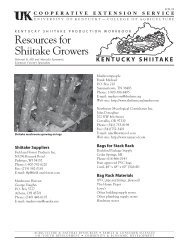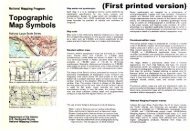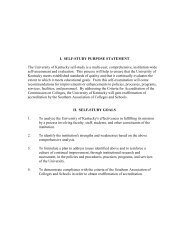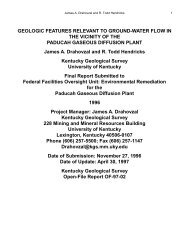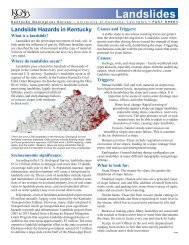Re-naturalizing sugar: narratives of place, production and ...
Re-naturalizing sugar: narratives of place, production and ...
Re-naturalizing sugar: narratives of place, production and ...
Create successful ePaper yourself
Turn your PDF publications into a flip-book with our unique Google optimized e-Paper software.
progressive among US sourcing regions, deserving<br />
<strong>of</strong> a greater share <strong>of</strong> the US market.<br />
In July 1960 President Dwight Eisenhower<br />
‘temporarily’ suspended Cuba’s <strong>sugar</strong> quota<br />
<strong>and</strong> lifted the restrictions on domestic producers.<br />
Sugar capitalists, invested in Cuba, were<br />
attracted to Florida by its latent potential for<br />
development <strong>and</strong> its access to the US <strong>sugar</strong><br />
market. Within five years, the Florida industry<br />
was transformed. To the existing two mills in<br />
the area, eight new mills were added <strong>and</strong> cane<br />
acreage increased five-fold. Some <strong>of</strong> the new<br />
investors, such as Alfonso Fanjul, were<br />
backed by the <strong>sugar</strong> brokerage firm,<br />
Czarnikow-Rionda, which also supplied capital<br />
to a group <strong>of</strong> Florida farmers for a co-operative<br />
<strong>sugar</strong> company. Noting that the price paid<br />
by one group <strong>of</strong> Cubans for 16,000 acres <strong>of</strong><br />
‘virgin swampy l<strong>and</strong>’ in Florida was three<br />
times what the USA had paid Spain for the<br />
entire state, a Spanish-language Miami paper<br />
declared that ‘the state <strong>of</strong> Florida should give<br />
thanks to Fidel Castro for its internal <strong>sugar</strong>bowl<br />
expansion’ (Avance 1961, author’s translation).<br />
Supermarket <strong>narratives</strong>, liberation marketing<br />
When <strong>production</strong> quotas were reinstated in<br />
1965 the Florida industry was again concerned<br />
with its public image. By then the industry’s<br />
use <strong>of</strong> <strong>of</strong>fshore workers for harvest was under<br />
scrutiny <strong>and</strong> executives identified labour as<br />
their ‘Achilles heel’. During the 1980s, as the<br />
Florida industry continued to import 10,000<br />
workers annually for the harvest season, public<br />
attention focused on cane-cutters’ living <strong>and</strong><br />
working conditions. At the same time, the<br />
industry came under increasing criticism for<br />
polluting the Everglades.<br />
By 1991 Florida Trend reported ‘the industry<br />
<strong>Re</strong>-<strong>naturalizing</strong> <strong>sugar</strong> 67<br />
is under siege like never before … The 1990s<br />
will be the <strong>sugar</strong> industry’s decade <strong>of</strong> reckoning’<br />
(<strong>Re</strong>snick 1991: 41). Arrayed against ‘Big<br />
Sugar’ were industrial sweetener users, consumer<br />
groups, labour advocates, foreign governments,<br />
environmentalists <strong>and</strong> government<br />
<strong>of</strong>ficials. As the politics <strong>of</strong> <strong>sugar</strong> sourcing <strong>and</strong><br />
Everglades restoration merged, environmental<br />
organizations <strong>and</strong> major sweetener users<br />
formed The Coalition to End Welfare to Big<br />
Sugar. Hershey, Coca-Cola, the Sierra Club<br />
<strong>and</strong> the Audubon Society joined forces, though<br />
their agendas differed. Sweetener users wanted<br />
to purchase <strong>sugar</strong> at world market prices,<br />
whereas environmental organizations sought to<br />
downsize the Florida industry. Prior to the 1995<br />
Farm Bill the Coalition published The Bittersweet<br />
Times, headlined ‘Aliens Earn Millions<br />
in Gov’t Bonanza’ referring to the Fanjul family,<br />
which owns the largest <strong>sugar</strong> company in<br />
Florida, Flo-Sun. Opponents portrayed the<br />
Florida industry as greedy, foreign, un-American,<br />
big business—run by <strong>and</strong> for ‘Sugar<br />
Barons’.<br />
The Florida <strong>sugar</strong> industry provides 20 per<br />
cent <strong>of</strong> the US <strong>sugar</strong> supply; <strong>of</strong> that, approximately<br />
75 per cent is produced by the two<br />
largest companies, USSC <strong>and</strong> Flo-Sun. Under<br />
attack, they chose disparate public relations<br />
<strong>and</strong> marketing strategies. USSC emphasized<br />
community, family, farming <strong>and</strong> nation so as<br />
to counter the image <strong>of</strong> ‘<strong>sugar</strong> barons’ (Sanchez<br />
1995). Their website, titled ‘An integrated family<br />
<strong>of</strong> agribusiness companies’, stressed two<br />
themes: the industrial aspects <strong>of</strong> <strong>sugar</strong> <strong>production</strong><br />
<strong>and</strong> company ties to community (USSC<br />
2001). In 1998 USSC began a marketing campaign,<br />
announcing a ‘New Sugar Breakthrough!’<br />
<strong>and</strong> urging consumers to ‘Try the<br />
New Sugar Bursting with Goodness’. The<br />
‘breakthrough’ was not the product—granulated<br />
white <strong>sugar</strong>, unchanged for over a century—but<br />
the red, white <strong>and</strong> blue packaging,


